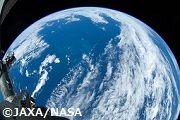| タイトル | SARインターフェログラム生成のための基礎的技術の開発 |
| その他のタイトル | Development of fundamental technology to generate SAR interferogram |
| 著者(日) | 米澤 千夏; 竹内 章司 |
| 著者(英) | Yonezawa, Chinatsu; Takeuchi, Shoji |
| 著者所属(日) | リモート・センシング技術センター 研究部; リモート・センシング技術センター 研究部 |
| 著者所属(英) | Remote Sensing Technology Center of Japan Research Department; Remote Sensing Technology Center of Japan Research Department |
| 発行日 | 1996-12-13 |
| 発行機関など | 財団法人・リモートセンシング技術センター
Remote Sensing Technology Center of Japan |
| 刊行物名 | RESTEC
RESTEC |
| 号 | 38 |
| 開始ページ | 28 |
| 終了ページ | 31 |
| 刊行年月日 | 1996-12-13 |
| 言語 | jpn |
| 抄録 | SAR(合成開口レーダ)によるインターフェロメトリーで、干渉縞(インターフェログラム)を生成するための基礎的手法の開発および地形縞パターンの抽出の試みを、富士山周辺地域をテストサイトとして行った。93年7月7日と8月20日に観測したJERS-1(日本地球資源衛星1号)/SARレベル0をデータとして用いた。レンジ(横)方向に繰り返す軌道縞を除去するために、軌道情報によるベースライン長を用いてスラントレンジ(衛星からの視線距離)に対する位相差の変化率を計算した。実際の軌道縞に一致させるように試行錯誤的な修正をした結果、本データの周波数最適値0.057?0.080(cycles/pixel)を得た。レンジ方向軌道縞の除去後に、アジマス方向の軌道縞周波数を推定して0.00264(cycles/line)を得た。推定された軌道縞の値とDEM(数値標高モデル)を用いて地形縞をシミュレーションした。ノイズ除去のため、得られたインターフェイス・プログラムを3×9の領域で平均化し、フィルタリングにより平滑化して、地形縞の連続性を向上させた。2つの複素SAR画像間の3×9領域で複素相関を計算し、さらに3×3の領域で平均化してコヒーレンシーマップを得た。最も複素相関が大きくなった位置が、位相差抽出の観点から最適な対応画素位置である。対応画素を最適化した後、位相差の抽出を試みることにより、地形縞の連続性を向上させることができた。
For interferometry with SAR (Synthetic Aperture Radar), the development of fundamental technology to generate interferograms and the extraction of topographical patterns were attempted in a test site around Mt. Fuji. The data used were of JERS-1 (Japanese Earth Resources Satellite-1)/SAR level zero on July seventh and August 20, 1993. To eliminate the orbital fringes repeatedly appearing in the along range (horizontal) direction, the rate of change in phase difference on slant-range (line-of-sight distance from a satellite) was calculated using baseline length obtained from orbital information. The optimum frequency of the interferogram was evaluated as 0.057-0.080 cycles/pixel by trial-and-error adjusting to the real orbital fringe. After eliminating the orbital fringe in the along range direction, the frequency of the orbital fringe in the along azimuth direction was estimated as 0.00264 cycles/line. The topographical fringe was simulated using the estimated orbital fringe and Digital Elevation Model (DEM). The continuity of the topographical fringe was improved by averaging over three times nine regions in an obtained interface program and filtering to smooth, hence eliminating noise. Complex correlation between two complex SAR images was calculated over three times nine regions and averaged over three times three regions to obtain a coherency map. A point of providing the greatest complex correlation is the optimum correspondent pixels from the view point of phase difference extraction. Having extracted the correspondent pixels, the continuity of topographical fringe was improved by extracting the phase difference. |
| キーワード | SAR; synthetic aperture radar; SAR interferogram; interferometry; topographical pattern; JERS 1; Japanese earth resources satellite 1; JERS 1/SAR level zero; orbital fringe; orbital information; baseline length; slant range; DEM; digital elevation model; simulation; SAR; 合成開口レーダ; SARインターフェログラム; インターフェロメトリー; 地形縞; JERS-1; 日本地球資源衛星1号; JERS-1/SARレベル0; 軌道縞; 軌道情報; ベースライン長; スラントレンジ; DEM; 数値標高モデル; シミュレーション |
| 資料種別 | Technical Report |
| ISSN | 0289-9086 |
| SHI-NO | AA0000618004 |
| URI | https://repository.exst.jaxa.jp/dspace/handle/a-is/51515 |

